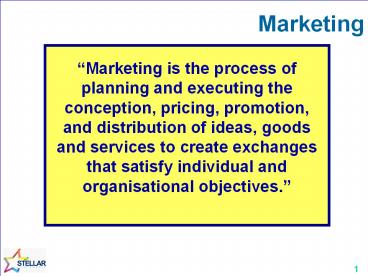Marketing - PowerPoint PPT Presentation
1 / 33
Title:
Marketing
Description:
Marketing is the process of planning and executing the conception, pricing, promotion, and distribution of ideas, goods and services to create exchanges that ... – PowerPoint PPT presentation
Number of Views:252
Avg rating:3.0/5.0
Title: Marketing
1
Marketing
Marketing is the process of planning and
executing the conception, pricing, promotion, and
distribution of ideas, goods and services to
create exchanges that satisfy individual and
organisational objectives.
2
Marketing Orientated
- Listen understand
- Put customer first
- Targetfocus
- Plan change and innovation
3
Marketing Levels
4
Marketing Process
5
Hierarchy of Plans
Corporate Plan
Business Plan
Marketing Plans
Functional Plans
Operational Plans
6
Marketing Planning
Input
Objectives
Operations
Control
7
Marketing Audit
8
SWOT
9
Good Strategies
10
Marketing Objectives
- Draw on SWOT
- Set marketing objectives around
- Markets
- Products
- Sales
- Profit
- Specific, Measurable, Agreed, Relevant,
Timebound, Extending, Rewarding
S.M.A.R.T.E.R.
11
Marketing Audit
- Providing context
- Raising issues and challenges
- Stakeholder analysis
12
Marketing Audit
- Strengths
- Weaknesses
Internal
- Opportunities
- Threats
External
13
Marketing Research
- List information needed
- Identify sources (secondary and primary)
- Choose most appropriate method
- Time
- Cost
- Effectiveness
- Action Plan (W3)
14
Marketing Research
- List Information
- Source
- Action Plan
15
Market Research
16
Market Research
ISSUES/ELEMENTS
SOURCES OF INFORMATION
- DEMOGRAPHY
- Population
- Age structure
- Distribution and Settlement Patterns
- Changes/immigration
- NI Census 1991 and 2001
- NISRA (www.nisra.gov.uk)
- Office for National Statistics
- www.detini.gov.uk
- www.economicstatistics-ni.gov.uk
- www.dardni.gov.uk
- www.nitb.com/tourismfacts/Default.htm
- www.dcalni.gov.uk
- www.artscouncil-ni.org/
- Trade Bodies/Institutes
- ECONOMY
- Sector Information
- Labour Forced/Unemployment/Skills
- Invest NI
- DCAL/Arts Council
- SOCIAL/COMMUNITY
- Planning
- Housing
- Education
- Health and Social Services
- Deprivation
- Noble Index
- District Housing Plan (NIHE)
- House Condition Survey (NIHE)
- HPSS Trust Strategy and Annual Report
- Director of Public Health Annual Report (HSSB)
- www.deni.gov.uk/facts_figures/index.htm
17
Make Assumptions
- Facts and figures butmake assumptions
- Restrict to the critical few
- Use Best Guess/Guestimate
- Necessary for informed decisions
18
PEST
Political
Economic
Technological
Social
19
PESTLE
20
SWOT
21
Robust Analysis
If you folded an A4 Sheet 32 times, how thick
would it be?
30
271 Miles
22
Strategy
Operational effectiveness means youre running
the same race faster. But strategy is choosing
to run a different race because its the one
youve set yourself up to win. Michael Porter
23
Ansoffs Matrix
Current Products
New Products
Current Markets
Market Penetration
Product Development
New Markets
Market Development
Diversification
24
Product/Market Expansion Grid
New Products
Existing Products
Products
Market Penetration Market penetration is a strategy of increasing your share of existing markets. This might be achieved by raising customers awareness of products and services or finding new customers. Product Development Product development is a strategy for enhancing benefits you deliver to customers by improving existing products and services or developing new ones.
Market Development Market development is a strategy of finding and entering new markets with current product or service range. The new market could be a new region, a new country or a new segment of the market. Diversification Diversification is a strategy that usually carries high costs and high risks. It often requires organisations to adopt new ways of doing business and so has consequences far beyond simply offering new products/services in a new market. It is therefore usually a strategy to be adopted when other options are not feasible.
Existing Markets
Markets
New Markets
Adapted from Ansoff I. (1968)
25
Boston Box
Stars
Question Marks
Relative Market Growth Rate
Cash Cows
Dogs
-
Relative Market Share
-
26
Directional Policy Matrix
27
CostFocusDifferentiation
Focus
Differentiation
Low Cost
28
Scenarios
- What if ?
- A visioning-type exercise
- Informed speculation not prediction
- Aim for four scenarios
- Strategic issues
- Key assumptions
- Implications
- Plan on one (or more) scenario
29
Kim, Chan W., and Mauborgne, Renee (2005) Blue
Ocean Strategy How to Create Uncontested Market
Space and Make the Competition Irrelevant Boston,
Harvard Business School Press.
30
The Four Actions Framework
Reduce Cost
Raise Demand
Particularly eliminate and create to make the
existing rules of competition irrelevant and
move beyond competition onto new space
31
- Six principles
- Formulation
- Reconstruct market boundaries
- Focus on the big picture, not the numbers
- Reach beyond existing demand
- Get the strategic sequence right
- Execution
- Overcome key organisational hurdles
- Build execution into strategy
Kim, Chan W., and Mauborgne, Renee (2005) Blue
Ocean Strategy How to Create Uncontested Market
Space and Make the Competition Irrelevant Boston,
Harvard Business School Press.
32
Strategy Canvas and Value Curve
High
Blue Ocean
Red Ocean
Low
Price
Marketing
Quality
New Factors
Prestige
New Factors
Factors
33
Marketing Mix
Stealth Marketing?































